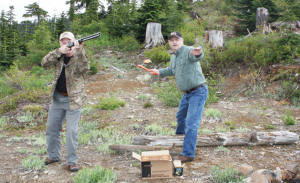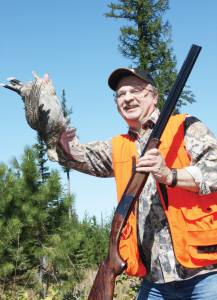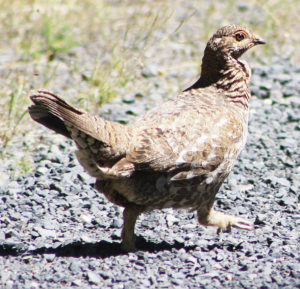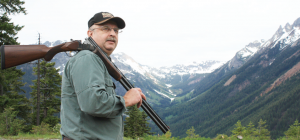by Dave Workman | Senior Editor
September’s arrival is greeted by wing shooters all over the country, whether it means the opening of mourning dove or grouse seasons, it opens up opportunities to pull the shotgun out of mothballs and get to work.

With Brian Lull at the ready, Workman gets ready to toss a clay target. Serious wing-shooters should be doing this already in preparation for fall hunting.
As this fall’s upland season unfolds, I’ll be in the high country of Washington State with a new Franchi Instinct L over-under smooth-bore (my faithful side-by-side will be along, naturally) to take on blue and ruffed grouse. Out in the Columbia Basin and through the Yakima Valley, dove gunners will be cranking off rounds, and they’ll have company all over the map, back to the Midwest and all the way down to Texas.
For grouse, many hunters have to wait for mid-September or even October, depending upon their state regulations, but the next several weeks will see shot gunners in their heyday.
Mourning dove hunters are in a class by themselves, especially the consistently successful ones. Hitting these artful dodgers is a gift, and I’ve known guys who spent a small fortune on no. 7½ or 8 shells just to fill one meager daily bag limit. The dove zips and weaves and zags and darts, and they are—at least according to dove devotees— the best game bird on the map.
That applies especially if one happens to be a masochist.
For those who have the talent, dove gunning is proof positive that later in the season, these guys will have no trouble putting chukar, pheasants, Hungarian partridge, ducks or geese in the bag because they are bigger and slower.
Check your local regulations for the opener, which in most places is Sept. 1, and be sure to stick to the bag limit.

Author has scored more than a few grouse in his career and with any luck, he’ll have a few more years beating the brush for fat specimens like this one.
Ruffed grouse fanciers are also a special breed. I’ve shot forest grouse for years and they are both fun and delicious table fare. As a challenging upland game bird, the ruffed grouse is a marvelous adversary, exploding from cover with a flurry of thundering wings that can startle the beejezus out of even the most experienced hunter.
The fellow with a good dog is well-equipped, and any shotgun will do, from the .410 bore all the way to a 12- gauge, though over the past several years, I’ve noticed a lot of people going to the 20- or 28-gauge guns (my new Franchi is a 20, chambered for 3-inch magnums, though I plan to stick with 2¾-inch shells) and they have managed a lot of birds.
It is not possible to put a precise number on the grouse taken by American hunters in a season. It’s probably in the six-figure range, if not seven.
Knowing habitat is the key, which applies equally to dove gunners working cut-over wheat fields and around water sources (cattle tanks are good attractors); to quail hunters who like those piney woods of the Southeast or western croplands.
For grouse, look to the hardwood forests, places with crabapple and berries, along creek bottoms where alder and vine maple can be found. But I’ve also found them in mixed woodlots with hardwoods and fir, hemlock and other evergreens.
My favorite is the bigger blue grouse of the West, though. These critters can weigh up to 2 or 3 pounds and they are often called “fool hens” because they are known to exhibit phenomenal stupidity by simply sitting still on logs or limbs, waiting to see what you’re going to do. That foolishness has put a fair number of them in my game bag, and this will seem like blasphemy to the grouse purists, but I’ve been known to shoot them out of trees or even on the ground with a .22 rifle or pistol.
Now comes the debate about blue grouse. Some time back, it was determined— probably by some bird biologist who didn’t have enough to do one day— that there are a couple of species of grouse, the sooty and dusky, that are closely related and have traditionally been lumped into the single “blue grouse” category. They’ve even gone so far as to give each version its own highfallutin’ designation. The Dusky is Dendragapus obscurus and the Sooty is Dendragapus fuliginosus. There’s a couple of $25 handles! My take on this is that they all taste the same.
Choke up! Where Vice President Joe Biden may think a double-barrel shotgun is just a peachy home defense weapon, savvy sportsmen and women from Maine to Washington know their far higher calling is to put birds in the bag. In the process, it helps to know a bit about them before heading into the timber.

Hen grouse struts along a Washington mountain
logging road. Workman found her on a recent summer scouting trek.
Double guns have either double triggers or single-selective triggers.
The double-trigger models pretty much do all of the thinking, as it were, because they’ll discharge the barrel with the wider choke first (the front trigger) and the other trigger controls the barrel with the tighter choke for follow-up shots. All three of my side-byside guns have double triggers, and only my Stoeger .410 has two full choke barrels, where the 20-gauge Stoeger has fixed Modified/Improved Cylinder chokes and my Beretta has a fixed Full/ Modified setup.
With the single trigger models, one must read the owner’s manual to initially set up your barrel discharge sequence. On my Franchi, I set the selector to discharge the lower barrel first, in which there’s an I/C choke tube, and the top barrel second, which is fitted with a Modified choke tube. I also have a Full that may be installed for the second shot later in the season.
Typically, the selector switch—which doubles as the thumb safety—is pressed to the left for the lower/upper sequence and to the right for the upper/lower sequence, but don’t count on it.
On some guns, there is no selector, so the barrels will always fire in the same sequence.
If you’re shooting a semi-auto or pump gun, keep your spare chokes handy for changes in shooting conditions.
Above all, never switch chokes on a loaded gun. Unload first and only then should you start swapping chokes.
For shooting grouse, pheasants or any other bird that erupts from cover, you definitely want a wider choke for a wider shot pattern at closer range. In those areas that require the use of steel shot (or some other non-toxic shot), remember to never use steel in a Full choke for lead. The Modified lead choke performs as the Full choke for steel, the I/C lead is the Modified steel, and so forth.
To get in practice for shooting on the wing, I recently headed into the higher country where I’ll be hunting these birds with my pal Brian Lull. We took a case of clay birds and a hand thrower, and started working out the kinks. This kind of preparation is as important as cleaning your gun and taking summer walks through the neighborhood to strengthen legs and ankles.
If there’s a range nearby, or you have the advantage of open land on which you can shoot, don’t waste any more time. Get out there and start practicing.
I think I paid $10 for a case of birds, and this is the time of year when I cruise the newspaper sport sections to find the shotgun shell sale ads. These are loss leaders designed to entice people into the stores to make other purchases. I’ve scored a season’s worth of shotgun shells with this strategy, sometimes hitting more than one outlet, or going back a second or third time while the special is on.

Workman’s new O/U Franchi shotgun is going to get a workout starting this month as he heads back into the “High Lonesome” in pursuit of fat fool hens.
On the hunt Years of hunting blue grouse have left me with some marvelous and, on occasion, hilarious experiences.
As noted earlier, they do tend to act really stupid at times by sitting on the ground until somebody beans them with a rock, but when they decide to get up and move, it’s like a jet launch.
I have seen them sit on high overlooks, above a logging road grade and take off when they see my vehicle coming, heading downhill to pick up speed and then gliding over to some other spot—within eyesight (how stupid is that?)—where they sit and wait anew.
Chukar over on the Snake River and in other high country environs are very much like that, igniting upwards and then almost immediately downhill into those canyon breaks in what appears to be a race to outrun the shot charge. I have shot chukars that rival high country grouse, and missed a few shots that should have been easy. Ah, well! On a recent scouting expedition, I ran into a blue grouse hen with a clutch of chicks, and she first stepped gingerly across the gravel road, waited to see what I was up to, then flew up onto a tree limb and watched some more. This is a habit blue grouse exhibit that astonishes me as a hunter. A guy with a .22 pistol and steady hand would have that bird in the cooler in just a few minutes, and I have known many a deer hunter who could shoot the heads off grouse with a rifle, and thus never come home without something for the table.
Once while hunting the big blues right at the top of Washington’s famous Teanaway Ridge with a test gun from Remington, I ran into a bunch of birds on an abandoned 4X4 road. I fired at one bird and then the whole hillside exploded with what seemed like a half-dozen of the buggers. It startled me so badly that I didn’t even cycle the action for a second shot.
On another occasion, I thought I’d scored a solid hit on a really big blue but the critter rolled, got up and stared straight at me as if to say “Well, what the hell’d you do that for?,” before it ran (and I mean at warp speed)—not flew— into the forest. I think I was laughing so hard it never occurred to me to shoot a second time.
Though I’ve never seen it, I have heard from reliable pals about blue grouse taking off only to fly right into a tree trunk and knock themselves silly.
Once many years ago, one of the dumber ones flew into a pal’s wind-shield and nearly caused a crash, which is no laughing matter on a road with a 500-foot drop on one side. And I’ve had the knuckleheads waiting for me after I emerged from the timber only to find them standing in front of my truck, as if they knew I couldn’t shoot them without hitting my vehicle, not that it would be legal anyway. You can’t shoot them in the road anywhere I know of because of hunting and forest laws, and I think they know it.
Ruffed and ready Ruffed grouse have a whole society of hunters named in their honor. These are challenging birds that seem to habitually take off and try to dodge around a big tree to put something solid between themselves and whatever startled them.
Hunting them over a good dog is a gentleman’s sport, but those of us who have hunted them without dogs have done fairly well over the years.
Grouse may fly 30 or 40 yards and then light on a tree limb, look around and glide back to the ground, or to another tree nearby if they think the coast is clear.
Some people will flush birds and then follow in their direction of flight, frequently picking up grouse on a rebound.
I’d never hunt the thick grouse cover with a Full-choke gun, choosing at most a Modified and now that I have a gun with interchangeable choke tubes, probably the I/C choke. You need that shot pattern to open up fast.
I know lots of people who hunt grouse, and chukar and pheasant for that matter, with 7½ shot, but I prefer No. 6s because they can get through heavy cover and nail a bird.
Last fall, Lull hunted with 3-inch 20- gauge shells in his over-and-under, but as noted earlier, I’m sticking with 2¾- inch field loads. They have plenty of horsepower to put the conk on grouse, and you don’t wasn’t to over-kill a bird on which you may be dining.
The important thing is to renew your hand-eye coordination, and that’s not as easy as some people think, especially as one gets older. It is imperative to tune your reflexes, and as one practices with a pal, make sure you don’t always yell “Pull” before he tosses a bird. Let your buddy surprise you and thus force you to quickly get on target. Grouse do not jump at command, nor does any other game bird, whether quail, ringneck or partridge. They erupt without warning, unless you are working over dogs and then the flush is a bit more predictable, though not always.



